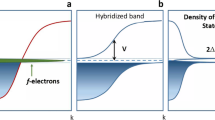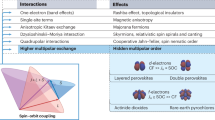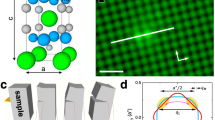Abstract
Complex electronic matter shows subtle forms of self-organization, which are almost invisible to the available experimental tools. One prominent example is provided by the heavy-fermion material URu2Si2. At high temperature, the 5f electrons of uranium carry a very large entropy. This entropy is released at 17.5 K by means of a second-order phase transition1 to a state that remains shrouded in mystery, termed a ‘hidden order’ state2. Here, we develop a first-principles theoretical method to analyse the electronic spectrum of correlated materials as a function of the position inside the unit cell of the crystal and use it to identify the low-energy excitations of URu2Si2. We identify the order parameter of the hidden-order state and show that it is intimately connected to magnetism. Below 70 K, the 5f electrons undergo a multichannel Kondo effect, which is ‘arrested’ at low temperature by the crystal-field splitting. At lower temperatures, two broken-symmetry states emerge, characterized by a complex order parameter ψ. A real ψ describes the hidden-order phase and an imaginary ψ corresponds to the large-moment antiferromagnetic phase. Together, they provide a unified picture of the two broken-symmetry phases in this material.
This is a preview of subscription content, access via your institution
Access options
Subscribe to this journal
Receive 12 print issues and online access
$259.00 per year
only $21.58 per issue
Buy this article
- Purchase on SpringerLink
- Instant access to full article PDF
Prices may be subject to local taxes which are calculated during checkout



Similar content being viewed by others
References
Palstra, T. T. M. et al. Superconducting and magnetic transitions in the heavy fermion system URu2Si2 . Phys. Rev. Lett. 55, 2727–2730 (1985).
Tripathi, V., Chandra, P. & Coleman, P. Sleuthing hidden order. Nature Phys. 3, 78–80 (2007).
Allen, J. W. The Kondo resonance in electron spectroscopy. J. Phys. Soc. Jpn 74, 34–48 (2005).
Broholm, C. et al. Magnetic excitations and ordering in the heavy-electron superconductor URu2Si2 . Phys. Rev. Lett. 58, 1467–1470 (1987).
Cox, D. L. Kondo effect in real metals. Phys. Rev. Lett. 59, 1240–1243 (1987).
Amitsuka, H. & Sakakibara, T. Single uranim site properties of the dilute heavy electron system UxTh1−xRu2Si2 . J. Phys. Soc. Jpn 63, 736–747 (1994).
Kotliar, G. et al. Electronic structure calculations with dynamical mean-field theory. Rev. Mod. Phys. 78, 865–951 (2006).
Kohsaka, Y. et al. How Cooper pairs vanish approaching the Mott insulator in Bi2Sr2CaCu2O8, approaching the Mott insulator. Nature 454, 1072–1078 (2008).
Schmidt, A. et al. Abstract number: BAPS.2009.MAR.V29.3, APS March Meeting, Pittsburgh (2009).
Fano, U. Effects of configuration interaction on intensities and phase shifts. Phys. Rev. 124, 1866–1878 (1961).
Denlinger, J. D. et al. Temperature dependent 5f states in URu2Si2 . J. Electron Spectrosc. Relat. Phenom. 117–118, 347–369 (2001).
Denlinger, J. D. et al. Abstract number: BAPS.2009.MAR.Q2.2, APS March Meeting, Pittsburgh (2009).
Broholm, C. et al. Magnetic excitations in heavy fermion superconductors. Phys. Rev. B 43, 12809–12822 (1991).
Villaume, A. et al. Signature of hidden order in heavy fermion superconductor URu2Si2: Resonance at the wave vector Q0=(1,0,0). Phys. Rev. B 78, 012504 (2008).
Wiebe, C. R. et al. Gapped itinerant spin excitations account for missing entropy in the hidden-order state of URu2Si2 . Nature Phys. 3, 96–99 (2007).
Kiss, A. & Fazekas, P. Group theory and octupolar order in URu2Si2 . Phys. Rev. B 71, 054415 (2005).
Pfleiderer, C., Mydosh, J. A. & Vojta, M. Pressure dependence of the magnetization of URu2Si2 . Phys. Rev. B 74, 104412 (2006).
Amitsuka, H. et al. Pressure–temperature phase diagram of the heavy-electron superconductor URu2Si2 . J. Magn. Magn. Mater. 310, 214–220 (2007).
Motoyama, G. et al. Electrical resistivity and thermal expansion measurements of URu2Si2 under pressure. J. Phys. Soc. Jpn 77, 123710 (2008).
Hassinger, E. et al. Temperature–pressure phase diagram of URu2Si2 from resistivity measurements and ac calorimetry: Hidden order and Fermi-surface nesting. Phys. Rev. B 77, 115117 (2008).
Jo, Y. J. et al. Field-induced Fermi surface reconstruction and adiabatic continuity between antiferromagnetism and the hidden-order state in URu2Si2 . Phys. Rev. Lett. 98, 166404 (2007).
Bonn, D. A., Garret, J. D. & Timusk, T. Far infrared properties of URu2Si2 . Phys. Rev. Lett. 61, 1305–1308 (1988).
van Dijk, N. H. et al. Specific heat of heavy-fermion URu2Si2 in high magnetic fields. Phys. Rev. B 56, 14493–14498 (1997).
Behnia, K. et al. Thermal transport in the hidden-order state of URu2Si2 . Phys. Rev. Lett. 94, 156405 (2005).
Matsuda, K. et al. Spatially inhomogeneous development of antiferromagnetism in URu2Si2: Evidence from 29Si NMR under pressure. Phys. Rev. Lett. 87, 087203 (2001).
Maple, M. B. et al. Partially gapped Fermi surface in the heavy-electron superconductor URu2Si2 . Phys. Rev. Lett. 56, 185–188 (1986).
Schoenes, J. et al. Hall-effect and resistivity study of the heavy-fermion system URu2Si2 . Phys. Rev. B 35, 5375–5378 (1987).
Elgazzar, S. et al. Hidden order in URu2Si2 originates from Fermi surface gapping induced by dynamic symmetry breaking. Nature Mater. 8, 337–341 (2009).
Kuramoto, Y., Kusunose, H. & Kiss, A. Diffraction from ordered states of higher multipoles. Physica B 383, 5–8 (2006).
Acknowledgements
We are grateful to J. Allen, J. Denlinger and J.C. Seamus Davis for fruitful discussion and for sharing unpublished work with us. K.H. was supported by grant NSF DMR-0746395 and an Alfred P. Sloan fellowship. G.K. was supported by NSF DMR-0906943.
Author information
Authors and Affiliations
Contributions
K.H. and G.K. both developed the LDA+DMFT methodology and the physical interpretation of the results.
Corresponding author
Supplementary information
Supplementary Information
Supplementary Information (PDF 227 kb)
Rights and permissions
About this article
Cite this article
Haule, K., Kotliar, G. Arrested Kondo effect and hidden order in URu2Si2. Nature Phys 5, 796–799 (2009). https://doi.org/10.1038/nphys1392
Received:
Accepted:
Published:
Issue date:
DOI: https://doi.org/10.1038/nphys1392
This article is cited by
-
Non-collinear magnetism driven by a hidden multipolar order in PrO2
Communications Physics (2024)
-
Proximity to a critical point driven by electronic entropy in URu2Si2
npj Quantum Materials (2021)
-
Chiral superconductivity in heavy-fermion metal UTe2
Nature (2020)
-
Unveiling hidden multipolar orders with magnetostriction
Nature Communications (2019)
-
High temperature singlet-based magnetism from Hund’s rule correlations
Nature Communications (2019)



